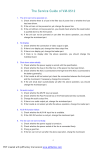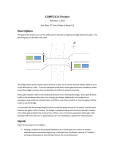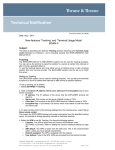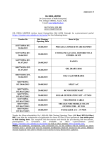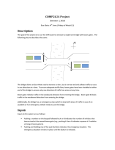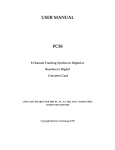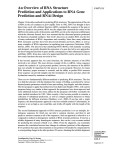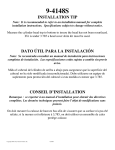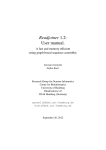Download SortMeRNA User Manual - Bonsai Bioinformatics
Transcript
SortMeRNA User Manual Evguenia Kopylova [email protected] May 2013, version 1.8 1 Contents 1 Introduction 3 2 Installation 2.1 Install from source code . . . . . . . . . . . . . . . . . . . . . . . . . . . . . . . . . . 2.2 Install from precompiled code . . . . . . . . . . . . . . . . . . . . . . . . . . . . . . . 2.3 Uninstall . . . . . . . . . . . . . . . . . . . . . . . . . . . . . . . . . . . . . . . . . . 3 3 5 6 3 Databases 6 4 How to run SortMeRNA 4.1 Index the rRNA database: command ‘buildtrie’ . . . . . . . . . . . . . . . . . . . . 4.1.1 Example 1: buildtrie . . . . . . . . . . . . . . . . . . . . . . . . . . . . . . . . 4.2 Filter reads against the indexed rRNA database: command ‘sortmerna’ . . . . . . . 4.2.1 Example 2: sortmerna on multiple databases, with output of accepted reads sorted by database . . . . . . . . . . . . . . . . . . . . . . . . . . . . . . . 4.2.2 Example 3: sortmerna on multiple databases, with output of accepted reads directed to one single file . . . . . . . . . . . . . . . . . . . . . . . . . . . . 4.2.3 Example 4: sortmerna on paired-end reads (1 input file - paired-end reads are interleaved) . . . . . . . . . . . . . . . . . . . . . . . . . . . . . . . . . . . . . 4.2.4 Example 5: sortmerna on forward-reverse paired-end reads (2 input files) . . 7 7 7 9 13 15 5 SortMeRNA parameters 16 2 10 12 1 Introduction Copyright (C) 2012-2013 Bonsai Bioinformatics Research Group (LIFL - Université Lille 1), CNRS UMR 8022, INRIA Nord-Europe SortMeRNA is a software designed to filter metatranscriptomic reads data. It takes as input a file of reads (fasta or fastq format) and an rRNA database file, and sorts apart the accepted reads and the rejected reads into two files specified by the user. For questions & help, please contact: 1. Evguenia Kopylova 2. Laurent Noe 3. Helene Touzet 2 [email protected] [email protected] [email protected] Installation Figure 1: sortmerna-vx directory tree sortmerna-vx src include scripts tests rRNA databases bacteria-16S.fasta ... automata bacteria-16S.bursttrief.dat bacteria-16S.bursttrier.dat bacteria-16S.kmer.dat ... 2.1 Install from source code 1. Download sortmerna-vx.tar.gz from http://bioinfo.lifl.fr/RNA/sortmerna 2. Extract the source code package into a directory of your choice, for quick installation without tests, type: 3 Quick Installation (no testing) > ./configure > make > make install (with root permissions) Go to Step 5. 3. For installation with testing, proceed by typing: > ./configure > make > make check 4. At this point, two executables buildtrie and sortmerna will be located in the sortmerna-vx directory, as well as the indexed rRNA databases in sortmerna-vx/automata. If the user would like to install the executables into /usr/local/bin and the sortmerna-vx directory into /usr/local/sortmerna-vx, then type, > make install (with root permissions) > make installcheck 5. SortMeRNA indexes a database by writing its contents to the ‘/automata’ folder (see Figure 1), which is initially located in the directory ‘/sortmerna-vx/automata’. It is essential to set the $SORTMERNADIR environmental variable to the path where the ‘/automata’ folder is found, so that the program may read and write from it. The user may move the ‘/automata’ folder to a workspace with larger memory, separately from the directory ‘/sortmerna-vx’. To find the path of the ‘/automata’ folder, go into the directory where it is located (we assume here it is located under the directory sortmerna-vx) and type, > pwd /path/to/sortmerna-vx Open the ˜/.bashrc (or ˜/.profile) file in any editor and add the line, > export SORTMERNADIR="/path/to/sortmerna-vx" If the user installed SortMeRNA in Step (2) or Step (4), go to Step (6). Otherwise, the user must also include the path of the executable files in the PATH variable (we assume buildtrie and sortmerna are located in the sortmerna-vx directory), > export PATH="$PATH:/path/to/sortmerna-vx" 6. Run the ˜/.bashrc (or ˜/.profile) file to add the variable $SORTMERNADIR and update the variable $PATH in the list of environment variables, > source ~/.bashrc or 4 > source ~/.profile 7. Check the path of the executables (if installed manually), > which sortmerna buildtrie /path/to/sortmerna-vx/sortmerna /path/to/sortmerna-vx/buildtrie 8. Check that $SORTMERNADIR has been added, > echo $SORTMERNADIR /path/to/sortmerna-vx (if it has not been added, this path will be empty) 9. To begin using SortMeRNA, type ‘buildtrie -h’ or ‘sortmerna -h’. If the user installed SortMeRNA in Step 3, then the public rRNA databases distributed with SortMeRNA have been indexed in $SORTMERNADIR/automata and the user may directly run the command sortmerna. Otherwise, the user must firstly index the databases with the command buildtrie before they can run the command sortmerna. 2.2 Install from precompiled code 1. Download the latest binary distribution of SortMeRNA from http://bioinfo.lifl.fr/RNA/ sortmerna 2. Extract the source code package into a directory of your choice, > tar -zxvf sortmerna-vx.tar.gz > cd sortmerna-vx 3. SortMeRNA indexes a database by writing its contents to the ‘/automata’ folder (see Figure 1), which is initially located in the directory ‘/sortmerna-vx/automata’. It is essential to set the $SORTMERNADIR environmental variable to the path where the ‘/automata’ folder is found, so that the program may read and write from it. The user may move the ‘/automata’ folder to a workspace with larger memory, separately from the directory ‘/sortmerna-vx’. To find the path of the ‘/automata’ folder, go into the directory where it is located (we assume here it is located under the directory sortmerna-vx) and type, > pwd /path/to/sortmerna-vx 4. Open the ˜/.bashrc (or ˜/.profile) file in any editor and add the line, > export SORTMERNADIR="/path/to/sortmerna-vx" > export PATH="$PATH:/path/to/sortmerna-vx" 5. Run the ˜/.bashrc (or ˜/.profile) file to add the variable $SORTMERNADIR and update the variable $PATH in the list of environment variables, 5 > source ~/.bashrc or > source ~/.profile 6. Check that $SORTMERNADIR has been added, > echo $SORTMERNADIR /path/to/sortmerna-vx (if it has not been added, this path will be empty) 7. Check that the $PATH has been updated with the additional directory search path, > echo $PATH /usr/local/bin:/usr/bin:...:/path/to/sortmerna-vx 8. Check the path of the executables, > which sortmerna buildtrie /path/to/sortmerna-vx/sortmerna /path/to/sortmerna-vx/buildtrie 9. To begin using SortMeRNA, type ‘buildtrie -h’ or ‘sortmerna -h’. If the user installed SortMeRNA in Step 3, then the public rRNA databases distributed with SortMeRNA have been indexed in $SORTMERNADIR/automata and the user may directly run the command sortmerna. Otherwise, the user must firstly index the databases with the command buildtrie before they can run the command sortmerna. 2.3 Uninstall If the user installed SortMeRNA using the command ‘make install’, then they can use the command ‘make uninstall’ to uninstall SortMeRNA (with root permissions). 3 Databases SortMeRNA comes prepackaged with 8 databases, representative database silva-bac-16s-database-id85.fasta silva-arc-16s-database-id95.fasta silva-euk-18s-database-id95.fasta silva-bac-23s-database-id95.fasta silva-arc-23s-database-id95.fasta silva-euk-28s-database-id95.fasta rfam-5s-database-id98.fasta rfam-5.8s-database-id98.fasta id % 85 95 95 98 98 98 98 98 average id % 91.6 96.7 96.7 99.4 99.5 99.1 99.2 98.9 # seq 8174 3845 4512 3055 164 4578 59513 13034 origin SILVA SSU Ref NR v.111 SILVA SSU Ref NR v.111 SILVA SSU Ref NR v.111 SILVA LSU Ref v.111 SILVA LSU Ref v.111 SILVA LSU Ref v.111 RFAM RFAM The tool UCLUST was used to reduce the size of the original databases. 6 # seq 244077 10919 31862 19580 405 9321 116760 225185 filtered to remove 23s 23s 26s,28s,23s 16s,26s,28s 16s,26s,28s 18s – – id %: members of the cluster must have identity at least this % id with the representative sequence average id %: average identity of a cluster member to the representative sequence Remark: The user must first index the fasta database by using the command buildtrie and then filter reads against the database using the command sortmerna. 4 How to run SortMeRNA 4.1 Index the rRNA database: command ‘buildtrie’ The executable buildtrie indexes an rRNA database. To see the man page for buildtrie, > buildtrie -h This program builds a Burst trie on an input rRNA database file in fasta format and stores the material in binary files under the folder ‘automata’ ./buildtrie --db [path to rrnas database file name {.fasta}] {OPTIONS} The list of OPTIONS can be left blank, the default values will be used: -L length of the sliding window (the seed) (default: 18) -F search only the forward strand -R search only the reverse-complementary strand (default: both strands are searched) -h help There are eight rRNA representative databases provided in the ‘sortmerna/rRNA databases’ folder. All databases were derived from the SILVA SSU and LSU databases (release 111) and the RFAM databases using the tool UCLUST. Additionally, the user can index their own database. 4.1.1 Example 1: buildtrie > buildtrie --db ~/sortmerna/rRNA_databases/silva-bac-16s-database-id85.fasta Burst trie(s) built in: 36.7594s Writing Burst trie forward to silva-bac-16s-database-id85.bursttrief.dat Writing Burst trie reverse to silva-bac-16s-database-id85.bursttrier.dat 7 Done. The indexed databases (ex. silva-bac-16s-database-id85.bursttrief.dat) will be stored in the directory ‘/some/path/to/sortmerna/automata’ (the path stored in variable $SORTMERNADIR, which was established in Step 1-4 of Subsection 2.2 or Subsection 2.3) and later retrieved by the command sortmerna, explained in the following section. 8 4.2 Filter reads against the indexed rRNA database: command ‘sortmerna’ The executable sortmerna filters rRNA reads against an indexed rRNA database. To see the man page for sortmerna, > sortmerna -h To run SortMeRNA, type in any order after ‘sortmerna’: --I [illumina reads file name {fasta/fastq}] --454 [roche 454 reads file name {fasta/fastq}] -n --db number of databases to use (must precede --db) [rrnas database name(s)] One database, ex 1. -n 1 --db /path1/database1.fasta Multiple databases, ex 2. -n 2 --db /path2/database2.fasta /path3/database3.fasta {OPTIONS} The list of OPTIONS can be left blank, the default values will be used: --accept --other [accepted reads file name] [rejected reads file name] (default: no output files are created) --bydbs output the accepted reads by database (default: concatenated file of reads) --log [overall statistics file name] (default: no statistics file created) --paired-in --paired-out put both paired-end reads into --accept file put both paired-end reads into --other file (default: if one read is accepted and the other is not, separate the reads into --accept and --other files) -r ratio of the number of hits on the read / read length (default Illumina: 0.25, Roche 454: 0.15) -F -R search only the forward strand search only the reverse-complementary strand (default: both strands are searched) -a number of threads to use 9 (default: 1) -m (m x 4096 bytes) for loading the reads into memory ex. ‘-m 4’ means 4*4096 = 16384 bytes will be allocated for the reads note: maximum -m is 1020040 (default: m = 262144 = 1GB) -v verbose (default: deactivated) -h help --version version number The command sortmerna takes as input a list of rRNA databases (in fasta format) and a set of Illumina or Roche 454 reads (in fasta or fastq format), and filters out the reads matching to at least one of the rRNA databases. The user has an option to output the accepted reads into a single file (default), or into multiple files sorted by the closest matching database (add the flag --bydbs). The indexed part of the databases created by buildtrie is loaded into sortmerna independently. The user can adjust the amount of memory allocated for loading the reads through the command option -m. By default, -m is set to be high enough for 1GB. If the reads file is larger than 1GB, then sortmerna internally divides the file into partial sections of 1GB and executes one section at a time. Hence, if a user has an input file of 15GB and only 1GB of RAM to store it, the file will be processed in partial sections using mmap without having to physically split it prior to execution. Otherwise, the user can set -m high enough to store all 15GB in RAM. 4.2.1 Example 2: sortmerna on multiple databases, with output of accepted reads sorted by database > sortmerna -n 3 --db ~/sortmerna/rRNA_databases/silva-bac-23s-database-id98.fasta ~/sortmerna/rRNA_databases/silva-bac-16s-database-id85.fasta ~/sortmerna/rRNA_databases/silva-euk-18s-database-id95.fasta --accept rrna --bydbs --454 SRR106861-filtered.fasta --log bilan -a 3 -v WARNING: option ‘--other’ has been left blank, no output file for rejected reads .. ------------------------------------------------------Welcome to SortMeRNA! Copyright (C) 2012 Bonsai Bioinformatics Research Group LIFL, Université Lille 1, CNRS UMR 8022, INRIA 2012 ------------------------------------------------------10 The size of the reads file <33862846> bytes will be executed in 1 partial section(s) of size <33862846> bytes [Partial section # 1] --------------------Time to mmap reads and set up pointers: 0.2164s Begin analysis of: ./rRNA_databases/silva-bac-23s-database-id98.fasta Time to load the Burst trie: Begin parallel traversal ... Time of parallel traversal of automata: 1.4488s 14.2974s Begin analysis of: ./rRNA_databases/silva-bac-16s-database-id85.fasta Time to load the Burst trie: Begin parallel traversal ... Time of parallel traversal of automata: 2.2975s 17.3430s Begin analysis of: ./rRNA_databases/silva-euk-28s-database-id98.fasta Time to load the Burst trie: Begin parallel traversal ... Time of parallel traversal of automata: 2.0302s Total number of reads found in current section: 95206 Time to output reads to file: Total number of reads found: 1.7558s 95206 19.0678s The option ‘--log bilan’ will create an overall statistics file called bilan.log, > cat bilan.log Time and Date Settings: r = 0.15 L = 18 reads file: ~/SRR106861-filtered.fasta Results: total reads: 105873 non-rRNA: 10667 rRNA: 95206 11 % rRNA: 89.92% silva-bac-23s-database-id98.fasta 64.39% silva-bac-16s-database-id85.fasta 25.53% silva-euk-28s-database-id98.fasta 0.009445% Now, we can manually check the number of reads matched per database: > grep -c ‘>’ rrna.* rrna.silva-bac-16s-database-id85.fasta:27026 rrna.silva-bac-23s-database-id98.fasta:68170 rrna.silva-euk-28s-database-id98.fasta:10 4.2.2 Example 3: sortmerna on multiple databases, with output of accepted reads directed to one single file > sortmerna -n 3 --db ~/sortmerna/rRNA_databases/silva-bac-23s-database-id98.fasta ~/sortmerna/rRNA_databases/silva-bac-16s-database-id85.fasta ~/sortmerna/rRNA_databases/silva-euk-18s-database-id95.fasta --accept rrna --454 SRR106861-filtered.fasta --log bilan -a 3 -v WARNING: option ‘--other’ has been left blank, no output file for rejected reads .. ------------------------------------------------------Welcome to SortMeRNA! Copyright (C) 2012 Bonsai Bioinformatics Research Group LIFL, Université Lille 1, CNRS UMR 8022, INRIA 2012 ------------------------------------------------------The size of the reads file <33862846> bytes will be executed in 1 partial section(s) of size <33862846> bytes [Partial section # 1] --------------------Time to mmap reads and set up pointers: 0.2184s Begin analysis of: ./rRNA_databases/silva-bac-23s-database-id98.fasta Time to load the Burst trie: Begin parallel traversal ... Time of parallel traversal of automata: 12 1.4594s 14.5262s Begin analysis of: ./rRNA_databases/silva-bac-16s-database-id85.fasta Time to load the Burst trie: Begin parallel traversal ... Time of parallel traversal of automata: 2.2632s 17.3602s Begin analysis of: ./rRNA_databases/silva-euk-28s-database-id98.fasta Time to load the Burst trie: Begin parallel traversal ... Time of parallel traversal of automata: 1.9980s Total number of reads found in current section: 95206 Time to output reads to file: Total number of reads found: 0.9978s 95206 19.4148s Now, we can manually check the number of reads matched for all databases: > grep -c ‘>’ rrna.* rrna.fasta:95206 4.2.3 Example 4: sortmerna on paired-end reads (1 input file - paired-end reads are interleaved) FASTQ paired-end reads @SEQUENCE ID 1/1 ACTT.. + QUALITY 1/1 @SEQUENCE ID 1/2 pair # 1 GTAC.. + QUALITY 1/2 .. Figure 2: Paired-end read format accepted by SortMeRNA This example illustrates three cases of output for paired-end reads: default, --paired-in and --paired-out. We use the set6-database.fasta found under Section 3.2 of the Supplementary file (also available online at bioinfo.lifl.fr/RNA/sortmerna/material.php). As for the reads, 5000 Illumina 13 paired-end reads were simulated using MetaSim on set6-database.fasta. The reads were then arranged to have 2475 pairs of rRNA, and the other 25 pairs where exactly one read is rRNA and the other is not (this is possible if one of the reads covers a low complexity region on the rRNA sequence). Remark: The statistics in the --log file will always give the true number of reads classified as rRNA. Case 1: We don’t care to keep the paired-end order in the output (default). > sortmerna -n 1 --db set6-database.fasta --I paired-end-5000-reads.fasta --accept rrna --other nonrrna --log bilan -a 1 > cat bilan.log Results: total reads: non-rRNA: rRNA: % rRNA: 5000 25 4975 99.5% set6-database.fasta 99.5% > grep -c ‘>’ rrna.fasta nonrrna.fasta rrna.fasta: 4975 nonrrna.fasta: 25 Case 2: We want to accept all pairs with at least one read that hits (--paired-in). > sortmerna -n 1 --db set6-database.fasta --I paired-end-5000-reads.fasta --accept rrna --other nonrrna --log bilan --paired-in -a 1 > cat bilan.log Results: total reads: non-rRNA: rRNA: 5000 25 4975 14 % rRNA: 99.5% set6-database.fasta 99.5% > grep -c ‘>’ rrna.fasta nonrrna.fasta rrna.fasta: 5000 nonrrna.fasta: 0 Case 3: We want to reject all pairs with at least one read that hits (--paired-out). > sortmerna -n 1 --db set6-database.fasta --I paired-end-5000-reads.fasta --accept rrna --other nonrrna --log bilan --paired-out -a 1 > cat bilan.log Results: total reads: non-rRNA: rRNA: % rRNA: 5000 25 4975 99.5% set6-database.fasta 99.5% > grep -c ‘>’ rrna.fasta nonrrna.fasta rrna.fasta: 4950 nonrrna.fasta: 50 4.2.4 Example 5: sortmerna on forward-reverse paired-end reads (2 input files) SortMeRNA accepts only 1 file as input for the reads. If a user has two input files, in the case for the foward and reverse paired-end reads (see Figure 3), they may use the merge-paired-reads.sh script found in ‘sortmerna/scripts’ folder to interleave the paired reads into the format of Figure 2. The command for merge-paired-reads.sh is the following, > bash ./merge-paired-reads.sh forward-reads.fastq reverse-reads.fastq outfile.fastq Now, the user may input outfile.fastq to SortMeRNA for analysis. 15 FASTQ forward reads @SEQUENCE ID 1/1 ACTT.. + QUALITY 1/1 @SEQUENCE ID 2/1 GTTA.. + QUALITY 2/1 .. FASTQ reverse reads pair # 1 pair # 2 @SEQUENCE ID 1/2 GTAC.. + QUALITY 1/2 @SEQUENCE ID 2/2 CCAC.. + QUALITY 2/2 .. Figure 3: Forward and reverse reads in paired-end sequencing format Similarly, for unmerging the paired reads back into two separate files, use the command, > bash ./unmerge-paired-reads.sh merged-reads.fastq forward-reads.fastq reverse-reads.fastq 5 SortMeRNA parameters There are two parameters in SortMeRNA which the user can moderate for performance: The length of the sliding window s (the seed), and the threshold ratio r of matching windows to the rRNA database for a read to be accepted. Both of these paramaters and their default values are discussed in detail in Section 2: Parameter Setting of the supplementary file. The user may adjust the threshold parameter r with the sortmerna command-line option -r [new ratio]. To adjust the length of the sliding window s, the user must provide the option -L [new length (even integer)] when indexing an rRNA database using the buildtrie executable. 16




















